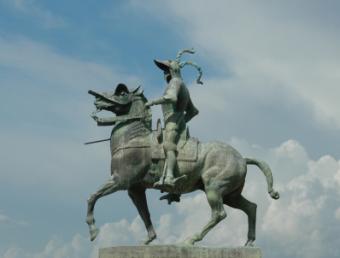
When most people think of the uniforms of Spanish Conquistadors, they picture the movies where teams of men in matching armor and crested helmets line up on the beaches. There's only one problem with that picture: it's wrong.
An Army of Men, Not Soldiers
Part of the problem with trying to assign a uniform such as the ones armies currently use to the Conquistadors is that they weren't actually an "enlisted" army of men. In fact, they weren't even known as "conquistadors" until long after their time had passed.
What they were, instead, were adventurers in search of the fabled gold and treasure, "where there's more gold and silver than iron in Biscay," as Gaspar de Marquina put it in 1533. And as individuals, they came equipped as best they could - with whatever weapons and armor they could afford and carry on the ships. They weren't actually members of the "Spanish Army" as there really wasn't an official army of Spain during that time - at least, not one that was subsidized by the crown.
During the 16th century, Spain went through a terrible civil war, much like the American one centuries later. The war left the government impoverished and the nation without any real resources except a lot of hard-bitten, tough fighters and whatever weapons they had with them. With nothing to be gained in their homeland, these soldiers went in search of fortune other places, and history dubbed them "conquistadors''.
The Mythical Uniforms of Spanish Conquistadors
Of course, due to the fact that they were all going to the same place, there were some similarities in the garb worn by the Spanish adventurers. Authentic examples can be found just west of San Diego at the Cabrillo National Monument. This national monument celebrates Juan Rodriguez Cabrillo, a conquistador and settler of the American continent, with authentic re-enactors wearing various outfits of the period.
The basic clothing consisted of a shirt, or camisa, a doublet (with or without sleeves), and some sort of pants, breeches, hose, or other covering for the lower body. The bulbous striped pantaloons portrayed in many films? They were never were worn by conquistadors; they didn't come into "fashion" until the Elizabethan age. If they were cavalry, they also had to have leather boots and gloves, but most foot soldiers just had simple shoes or the even cheaper sandals made from native American yucca fiber.
The image of the renaissance fighting man includes armor, but the fact is, most armor was far too expensive for a conquistador, the equivalent of a luxury car today. In the Cabrillo expedition, for example, out of the 287 soldiers, only nine - Cabrillo and his senior officers - actually had full plate armor. Most others wore helmets and some type of chainmail over thick cotton gambeson shirts to protect their torsos.
The shiny metal greaves and vambraces - coverings for the lower legs and forearms that are so popular in Renaissance festivals - were shunned by the Spanish adventurers, who preferred having their hands and arms free. Most of their other equipment, especially weapons, were obsolete by the standards of Europe of the time. That made it cheaper and often easier to acquire those weapons and bring them over to the new world.
Dress to Impress vs. Dress for Success
Summing up the uniforms of Spanish conquistadors, the closest thing to a uniform were the more elaborate armor and modern equipment officers wore in order to impress and sometimes cower the unruly mob of men who they hoped to use to build a home in this new world. The rest of the conquistadors - the sailors and everyday soldiers in the field - were far more utilitarian and concerned with efficiency and economy over appearance.
This is good news for anyone hoping to create an "authentic" conquistador uniform. Rather than trying to match the specific outfits of a movie, they can create their own individual rugged soldierly outfit, making it a truly personal experience in reliving history.







